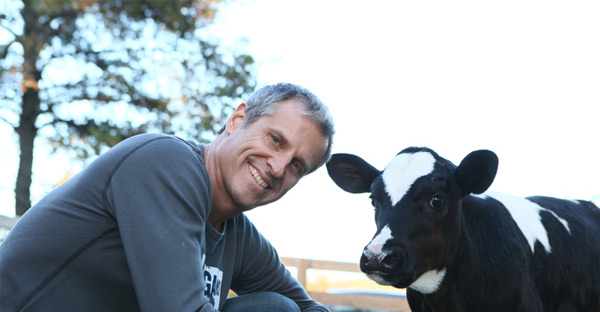

Did you know that livestock production has a larger impact on climate change than all transportation impacts combined? It can be argued that the single most important action that each and every one of us can take to reduce climate change, is to change what is on the end of our forks.
1. The October 2018 UN Climate report calls for everyone to eat 30% less animal products.[1]
The same report also reveals that we have until 2030 to limit global warming if we wish to avoid a significantly heightened risk of extreme heat, droughts, floods, and poverty affecting hundreds of millions of people around the world.[2] Although greenhouse gas emissions are typically associated with the transportation sector, industrial processes and fossil fuels, a comprehensive 2006 analysis by the UN Food and Agriculture Organization showed that livestock production accounted for 18% of all greenhouse gas (GHG) emissions worldwide, already more than the entire transportation sector. A later analysis by the Worldwatch Institute found that the FAO estimate was actually quite conservative, and that livestock production actually accounts for up to 51% of the worldwide GHG emissions![3] A plant-based diet produces 50% less carbon dioxide[4], uses 1/11th oil, 1/13th water[5], and 1/18th land, compared to a meat-heavy diet.[6]
2. Animal agriculture accelerates mass extinction, starvation, obesity, malnutrition, and climate change.
We are currently experiencing the greatest mass extinction in 65 million years.[7] Experts estimate that up to 137 plant, animal, and insect species are lost every day due to rainforest destruction[8], and we could see fishless oceans by 2048. It is estimated that 25% of the world’s total GHG production comes from deforestation alone.[9] When areas are deforested, the carbon dioxide stored in those trees is released into the atmosphere. Moreover, instead of using land to grow crops that feed people, at least 70% of all agricultural land, and up to 45%[10] of Earth’s land surface is used for livestock production. In fact, 40% of the land that is used to grow grain is used to feed animals.[11] Meanwhile, one billion people go to bed hungry every night.[12] Not only is animal agriculture accelerating climate change, but the meat-heavy diet it feeds is contributing to an obese, yet malnourished population and an epidemic of diet related diseases.[13]
3. Factory farms have devastating impacts.
The majority of meat, milk, and eggs produced in the U.S. – 95% of pigs, 78% of cattle, and 99.9% of chickens[14] – come from animals raised in factory farms.[15] The GHG emissions of methane and nitrous oxide from factory farms are a significant driver of climate change. Nitrous oxide has more than 300 times the global warming potential of carbon dioxide, and methane has more than 80 times the potential over 20 years.[15] In 2006, factory farms in the U.S. were responsible for emitting almost nine million tons of methane.[16]
4. Climate change leads to rising sea levels.
As global temperatures heat up, they gradually melt sea ice, and fewer bright surfaces are available to reflect sunlight back into the atmosphere.[17] More solar energy is absorbed at the surface, and ocean temperatures rise. Warmer water temperatures delay ice growth in the fall and winter, and the ice melts faster the following spring, exposing dark ocean waters for a longer period the following summer.[17] Changes in the amount of sea ice can disrupt normal ocean circulation, leading to changes in global climate.[17] In addition, as these polar ice caps melt, sea levels rise, ultimately leaving hundreds of millions of people increasingly vulnerable to flooding, and catastrophic storm surges when storms hit.[18]
5. Climate change is depleting our water, while animal based diets waste trillions of gallons of water annually.
Warmer temperatures increase the rate of evaporation of water into the atmosphere, in effect increasing the atmosphere’s capacity to “hold” water.[19] Increased evaporation may dry out some areas and fall as excess precipitation on other areas. As temperatures rise, people and animals need more water to maintain their health and thrive.[19] Although it is useful to take shorter showers, the reality is the most impactful change anyone can make is eating less meat. It is instructive to compare the water usage inputs of a meat-based diet to plant-based diets: 46 gallons for 1 lb vegetables; 196 gallons for 1 lb cereals/grains; 485 gallons for 1 lb legumes; 368 gallons for 1 lb almonds.[20] To produce just one pound of beef[21], 1,850 gallons of water are used. Indeed, the average dairy farm uses 3.4 million gallons of water per day.[22]
6. Consuming grass-fed beef does not mitigate climate impacts.
While grass-fed cattle are claimed to be “happy” and “healthier,” the impacts on our planet are still comparable to conventional beef. Grass-fed cattle still emit the same amount of methane, and they take up a significant portion of our agricultural land for grazing and feed.[23] Grazed beef accounts for between a quarter and a third of all GHG emissions from ruminant livestock.[23]
Did You Know There Are Things We Can Do to Combat Climate Change?
7. There’s good news: Our food choices can almost immediately reduce greenhouse gas impacts.
The largest source of agricultural GHG emissions is enteric fermentation – methane produced by livestock during digestion and released via belches into the atmosphere.[24] Methane traps over 80 times more heat in the atmosphere than carbon dioxide within a 20 year period[24], making its effects much worse than that of carbon dioxide. The good news is that methane, with an atmospheric half life of seven years, disappears from the atmosphere far faster than carbon dioxide. So as we eliminate sources of methane (i.e., reduce growing livestock for food), its contribution to the climate change begins to wane significantly.[25]
8. The economics of the food system can be fixed to reflect our climate priorities.
This includes lending rates, fiscal policy, subsidies, making financing available for sustainable actions, and more. This could include mainstreaming the Sustainable Development Goals (SDGs),[26] by creating incentives for financial institutions to become compliant with the SDGs—i.e., making the SDGs good for business. For example, we should create incentives to restore forests and degraded lands and use smarter farming practices to capture more carbon.[27] On the flip side, it is crucial that we end subsidies that support foods that accelerate climate change. Washington’s food subsidy programs do not benefit our planet or our health.[28] A review of the more than $246 billion in food subsidies between 1996 and 2009 demonstrates that the foods subsidized by the government starkly contrast with those recommended for health. Fruits, vegetables, nuts and legumes for human consumption receive only about 2% of all subsidies.[28] Also there is a need to find ways to internalize the true cost of unsustainable food into the point of consumption.
9. Widespread adoption of a plant-based diet would help people, the environment, and our healthcare crisis.
Studies show that widespread adoption of a vegetarian or vegan diet would cut food-related emissions by 63% and 70% respectively,[29] (and make people healthier too!). Without a reduction of 50% in meat consumption and production, livestock operations will use up 50% of the world’s carbon budget by 2050, resulting in catastrophic global warming.[30] While the October 2018 UN Intergovernmental Panel on Climate Change (IPCC) report[1] calls for 30% reduction in animal product consumption by everyone, the more plants we eat, the better for our planet and for our health!
For more information, please visit the PlantPure Communities Food-Climate Connection Initiative:
https://plantpurecommunities.org/foodclimateinitiative/
References
- http://www.ipcc.ch/report/sr15/
- http://www.onegreenplanet.org/news/un-warns-twelve-years-reduce-carbon-emissions-heres-how-you-can/
- http://www.worldwatch.org/files/pdf/Livestock%20and%20Climate%20Change.pdf
- https://link.springer.com/article/10.1007/s10584-014-1169-1
- https://academic.oup.com/ajcn/article/78/3/660S/4690010
- http://www.onegreenplanet.org/animalsandnature/facts-on-animal-farming-and-the-environment/
- http://advances.sciencemag.org/content/1/5/e1400253.full
- https://www.savetheamazon.org/rainforeststats.html
- http://climate.org/deforestation-and-climate-change/
- https://cgspace.cgiar.org/bitstream/handle/10568/10601/IssueBrief3.pdf
- https://www.worldhunger.org/world-hunger-and-poverty-facts-and-statistics/
- Zacharias, Nil, and Gene Stone. Eat For The Planet: Saving the World, One Bite at a Time. Abrams Image, pp 55, 2018
- http://www.dailycal.org/2017/03/21/consumption-animal-products-affects-health/
- https://www.huffingtonpost.com/nil-zacharias/its-time-to-end-factory-f_b_1018840.html
- http://environmentalintegrity.org/wp-content/uploads/FACT-SHEET-on-air-pollution-from-factory-farms.pdf
- EPA, Overview of Greenhouse Gases, http://epa.gov/climatechange/ghgemissions/gases/ch4.html.
- https://oceanservice.noaa.gov/facts/sea-ice-climate.html
- https://www.nationalgeographic.com/environment/global-warming/sea-level-rise/
- https://19january2017snapshot.epa.gov/climate-impacts/climate-impacts-water-resources_.html
- https://www.hydrol-earth-syst-sci.net/15/1577/2011/hess-15-1577-2011.pdf
- https://waterfootprint.org/en/water-footprint/product-water-footprint/water-footprint-crop-and-animal-products/
- http://www.onegreenplanet.org/animalsandnature/the-dairy-industry-and-the-environment/
- https://www.carbonbrief.org/grass-fed-beef-will-not-help-tackle-climate-change
- http://www.onegreenplanet.org/animalsandnature/methane-vs-carbon-dioxide-a-greenhouse-gas-showdown/
- Campbell, T. Colin, and Howard Jacobson. Whole: Rethinking the Science of Nutrition. Benbella Books, p. 168, 2014
- https://sustainabledevelopment.un.org/sdgs
- https://www.cnn.com/2018/10/08/opinions/un-climate-report-decarbonization-steer/index.html
- https://www.pcrm.org/health/reports/agriculture-and-health-policies-ag-versus-health
- https://www.theguardian.com/environment/2016/mar/21/eat-less-meat-vegetarianism-dangerous-global-warming
- https://www.theguardian.com/environment/2012/apr/13/less-meat-prevent-climate-change
Copyright 2025 Center for Nutrition Studies. All rights reserved.
Deepen Your Knowledge With Our
Plant-Based Nutrition
Certificate
Plant-Based Nutrition Certificate
- 23,000+ students
- 100% online, learn at your own pace
- No prerequisites
- Continuing education credits





